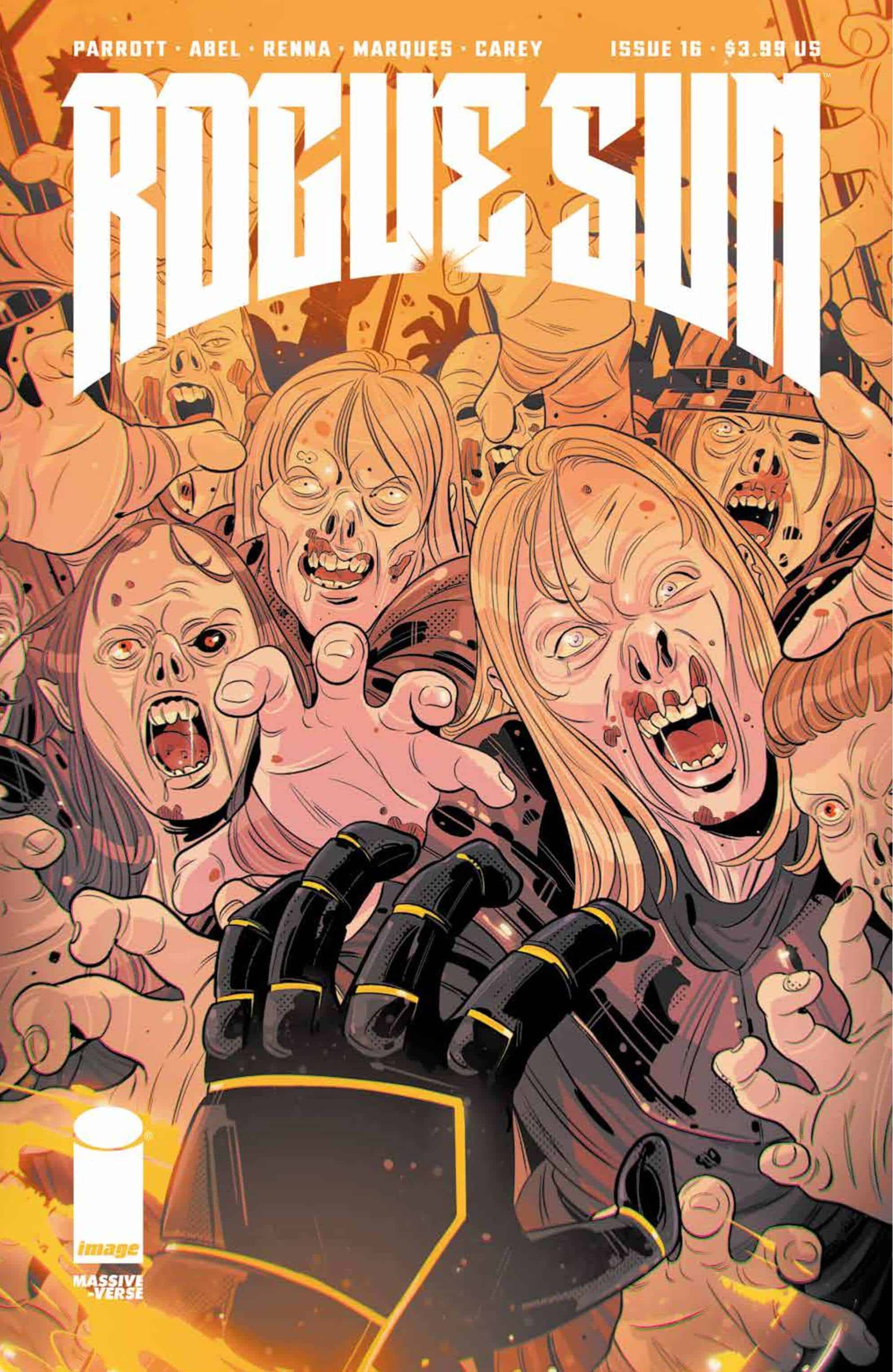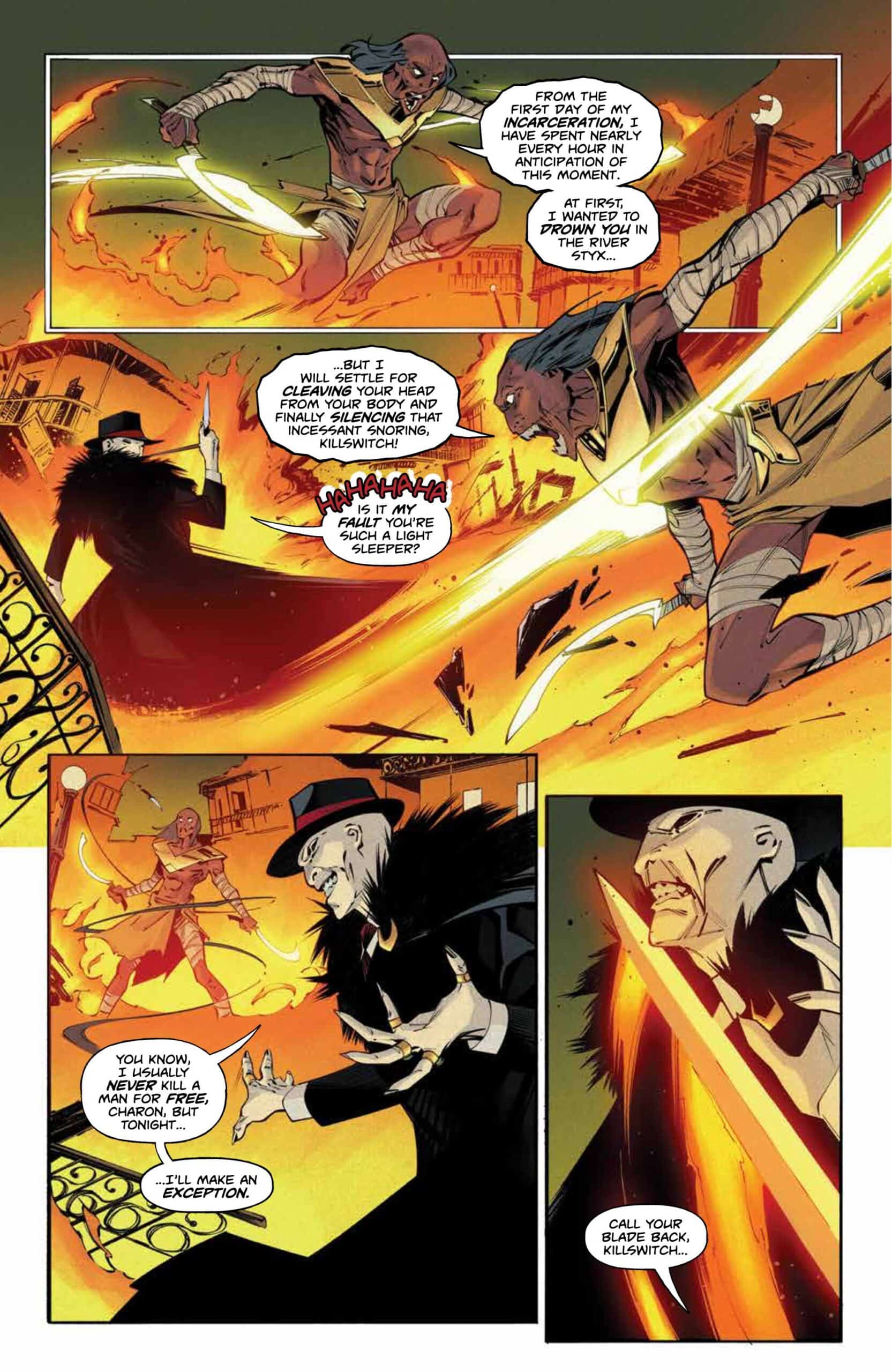Rogue Sun #16

Recap
An army of nightmares begins its march on New Orlean's and with Dylan still nowhere to be found and his friends and family scattered, who will step up to save the city? And, more importantly, how?
Review
Things go from bad to worse in Rogue Sun #16. Whether in the Sun Stone or the real world, none of the series’ heroes are having much success against Caleb. But as this story arc proceeds with no shortage of action, it doesn’t make quite as much room for the character focus that makes the series great.
 Caleb adds to his power base in Rogue Sun #16 after freeing a number of supernatural prisoners. He dispatches one of them named Reverend Death to raise additional forces in the form of apparent zombies. Meanwhile Caleb leads the rest of his allies on an attack on Dylan’s house only to be confronted by Dylan’s family who have taken on supernatural personas. None of this is known to Dylan, Marcus, and Owen who continue to fight old Rogue Suns within the Sun Stone.
Caleb adds to his power base in Rogue Sun #16 after freeing a number of supernatural prisoners. He dispatches one of them named Reverend Death to raise additional forces in the form of apparent zombies. Meanwhile Caleb leads the rest of his allies on an attack on Dylan’s house only to be confronted by Dylan’s family who have taken on supernatural personas. None of this is known to Dylan, Marcus, and Owen who continue to fight old Rogue Suns within the Sun Stone.
Rogue Sun is at its best when focused on Dylan–both his growth as a young man and his relationships with friends and family. Dylan’s imprisonment in the Sun Stone has allowed Parrott to explore Dylan’s relationship with his dead father and grandfather, Marcus and Owen. Rogue Sun #16 puts a period on at least part of that story. Owen’s explanation of why he was so hard on Marcus and how he never wanted him to become Rogue Sun puts everything Dylan and Marcus think they know about his behavior in context. The result is a backstory that’s more complicated and even somewhat tragic. Owen thought that what he was doing was truly in Marcus’ best interest even though he recognizes that the emotional abuse irreparably destroyed their relationship.
Caleb’s arc continues to lean hard into stereotypical, two-dimension villain territory. His initial portrayal after being conjured as well as how he presented himself when he first took over Dylan’s body was compelling and carried with it some nuance. All of that feels lost now.
Dylan’s family gets involved in the Caleb conquest story arc in Rogue Sun #16. They’ve demonstrated some supernatural ability in the past (such as when Dylan’s brother and sister started this whole story arc by conjuring Caleb in the first place). But their inclusion as combatants is sudden. Even with Dotty’s apparent presentation of magical items to give Dylan’s family supernatural abilities, this development feels unearned.
Asim’s story about failing to save Cleopatra is a fascinating revelation. To this point, Rogue Sun has been presented as a general hero out to beat the bad guys. Asim’s choices reflect a definite agenda. It casts a little bit of a shadow over the Rogue Sun legacy, and it will be interesting to see if Dylan’s interactions with his predecessors (to say nothing of Caleb’s actions) influence his future behavior as Rogue Sun.
Abel and Renna consistently show their versatility. As a series, Rogue Sun has no shortage of confrontation. At the same time, Abel and Renna never fail to keep the characters emotional and in-line with what the dialogue and actions suggest is going on. The latter is on display in Rogue Sun #16. It stands out particularly in the interactions between Dylan, Marcus, and Owen. Noteworthy with these interactions is the fact that the characters’ expressiveness is accomplished largely with very conservative lines and shading. Much of it comes through via characters’ eyes and mouths. This is especially true in this issue with Owen. There are more lines on his face to communicate his age, but Abel and Renna don’t really use those details to further communicate emotion.
Body language is also key in emotional communication. This is frequently the case with Owen, and it enhances the emotional dialogue about his and Marcus’ past. Abel and Renna do this exceptionally well.
The color palette in this issue might be the most varied of the series. The issue bounces between a number of settings and features a variety of characters, all of which have a distinct visual identity. The orange/red of the Rogue Suns still stand out more than anything else, but it has a great deal of company in this issue.
Those new characters are further distinguished by Carey’s lettering choices. The villains that Caleb frees all have their own fill colors for dialogue bubbles as well as border and text colors.
Final Thoughts
The Caleb-turned-villain arc continues to be the least interesting component of Rogue Sun to date. The dynamic between Dylan, Marcus, and Owen is elevating these issues. The additional backstory that Rogue Sun #16 provides elevates this issue in particular. While it’s not an ideal issue for new readers, it will satisfy the existing audience.
Rogue Sun #16: Sins of the Father
- Writing - 8.5/108.5/10
- Storyline - 8/108/10
- Art - 9/109/10
- Color - 9.5/109.5/10
- Cover Art - 8/108/10




